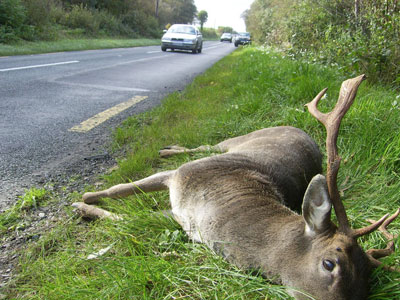| .... |
Every year, people are injured in road collisions with wild deer around Ireland. The periods of highest risk are winter and spring, particularly around dawn and dusk. A key to reducing the number and severity of these incidents is to get drivers to be 'DeerAware' - to slow down and watch out when they see deer warning signs at the roadside.
As winter approaches, the Road Safety Office of Mayo County Council and National Parks & Wildlife Service with The Deer Aware campaign are reminding drivers to watch out for deer, particularly at dawn and dusk.
"There are at least three species of wild deer in Ireland and around two million private cars in Ireland, and the population of deer is increasing as have other road users. As days get shorter in the autumn, busy traffic times coincide with dawn and the early part of the night when deer are most active and hardest to spot. In wooded areas in particular, there may be very little warning before one or several deer bolt across" said Denis Strong "Better data is helping to focus on locations where we know there have been a higher number of collisions with deer so we can use preventative measures - such as warning signs and advice to drivers - as effectively as possible." Said Mr Noel Gibbons, Road Safety Officer. "There are collision hotspots where there are high traffic volumes and high deer numbers, but drivers are advised to be aware that deer may cross near any wood land areas. "Car collisions involving deer are more common as the number of deer increases. Such collisions not only result in serious injuries or death for the deer, but they can also cause serious injuries - or worse - for the people involved as well." "We really need drivers to slow down, take extra care and watch out for these animals - especially at this time of year." © Copyright 2011 by © Contributor(s) and Castlebar Web Pages 1997 - 2011 .. Top of Page |
Error processing SSI file
